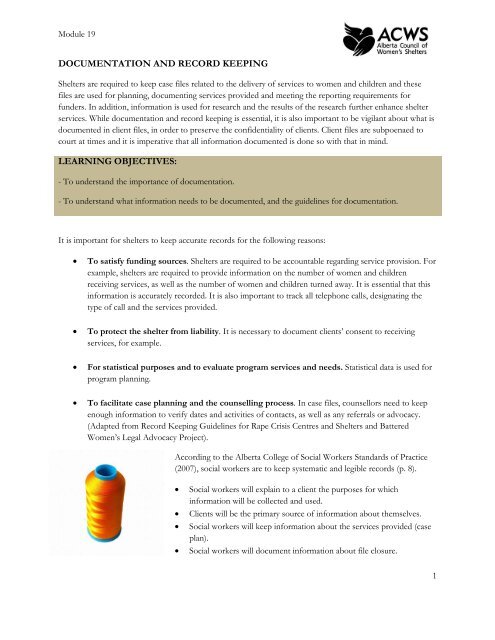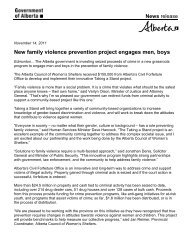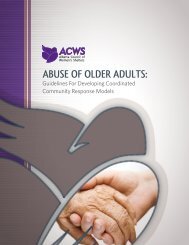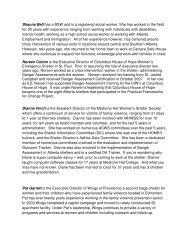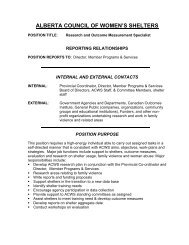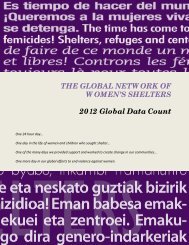documentation and record keeping learning objectives
documentation and record keeping learning objectives
documentation and record keeping learning objectives
- No tags were found...
Create successful ePaper yourself
Turn your PDF publications into a flip-book with our unique Google optimized e-Paper software.
Module 19DOCUMENTATION AND RECORD KEEPINGShelters are required to keep case files related to the delivery of services to women <strong>and</strong> children <strong>and</strong> thesefiles are used for planning, documenting services provided <strong>and</strong> meeting the reporting requirements forfunders. In addition, information is used for research <strong>and</strong> the results of the research further enhance shelterservices. While <strong>documentation</strong> <strong>and</strong> <strong>record</strong> <strong>keeping</strong> is essential, it is also important to be vigilant about what isdocumented in client files, in order to preserve the confidentiality of clients. Client files are subpoenaed tocourt at times <strong>and</strong> it is imperative that all information documented is done so with that in mind.LEARNING OBJECTIVES:- To underst<strong>and</strong> the importance of <strong>documentation</strong>.- To underst<strong>and</strong> what information needs to be documented, <strong>and</strong> the guidelines for <strong>documentation</strong>.It is important for shelters to keep accurate <strong>record</strong>s for the following reasons:To satisfy funding sources. Shelters are required to be accountable regarding service provision. Forexample, shelters are required to provide information on the number of women <strong>and</strong> childrenreceiving services, as well as the number of women <strong>and</strong> children turned away. It is essential that thisinformation is accurately <strong>record</strong>ed. It is also important to track all telephone calls, designating thetype of call <strong>and</strong> the services provided.To protect the shelter from liability. It is necessary to document clients’ consent to receivingservices, for example.For statistical purposes <strong>and</strong> to evaluate program services <strong>and</strong> needs. Statistical data is used forprogram planning.To facilitate case planning <strong>and</strong> the counselling process. In case files, counsellors need to keepenough information to verify dates <strong>and</strong> activities of contacts, as well as any referrals or advocacy.(Adapted from Record Keeping Guidelines for Rape Crisis Centres <strong>and</strong> Shelters <strong>and</strong> BatteredWomen’s Legal Advocacy Project).According to the Alberta College of Social Workers St<strong>and</strong>ards of Practice(2007), social workers are to keep systematic <strong>and</strong> legible <strong>record</strong>s (p. 8).Social workers will explain to a client the purposes for whichinformation will be collected <strong>and</strong> used.Clients will be the primary source of information about themselves.Social workers will keep information about the services provided (caseplan).Social workers will document information about file closure.1
BENEFITS OF RECORD KEEPING IN SHELTERSAppropriate <strong>record</strong> <strong>keeping</strong> can: (Adapted from Records Management Guidelines).Document the fact that the client provided informed consent to receive services while staying at ashelter.Ensure that client <strong>record</strong>s contain enough information to meet the needs of funders, as well asindividual shelter requirements.Help ensure that the content of client <strong>record</strong>s respects confidentiality to the best extent possible,given that in certain cases there may be a legal requirement to disclose information to third parties(in cases where files are subpoenaed).Help ensure that clients have adequate information about the services provided.Help staff be accountable to their clients.Help staff review the effectiveness of the case plans developed for each woman residing in theshelter.Help staff receive supervision/consultation regarding a particular case.Help to ensure consistent services are provided when the client receives support <strong>and</strong> interventionsfrom more than one counsellor, or when a file is transferred from one counsellor to another.Assist the shelter in providing information <strong>and</strong> support on behalf of a client, if a client requests staffto advocate or make a referral on her behalf.Document the actions of staff in cases where there are allegations of neglect or inappropriateactions.Help develop <strong>and</strong> implement a safety plan with a client. Documented information can be referred towhen assisting a client with developing a safety plan.Document that staff have satisfied legal or statutory reporting requirements, such as the requirementto report suspected child abuse.GUIDELINES FOR DOCUMENTATION (Adapted from Records Management Guidelines, 2006).- Always obtain informed consent from a client before providing professional services. Where possible,clients should provide their signature, indicating that they are agreeing to services. If a client is illiterate orunable to sign their name, ensure it is documented that the client verbally agreed to services.- Keep case notes on a session-by-session basis.- Write case notes as soon as possible after each session.- If h<strong>and</strong> written notes are taken <strong>and</strong> then later entered into the HOMES data base, the h<strong>and</strong> written notescan be destroyed (shredded).- Record the date of each session, <strong>and</strong> indicate the length of each session. Each shelter has policies around<strong>documentation</strong> – some are entering case notes directly in HOMES, others are using a h<strong>and</strong> written case note6/17/2010 2
procedure. Case notes should be signed in ink (blue or black ink), then the counsellor’s name should beprinted, <strong>and</strong> their designation added. In the case of HOMES notes, individual shelters determine when thesenotes are printed <strong>and</strong> placed in the files. When they are printed, counsellors should sign their names <strong>and</strong> addtheir professional designations to their entries.- Use the term “staff” or “writer” to identify yourself when writing case notes.- Entries should be relevant to the needs of the client <strong>and</strong> the provision of services to the client.- Case notes should be brief. Discuss major topic areas. For example: reviewed safety plan; discussed client’sfeelings about the separation; talked about the client’s goals during her shelter stay.CAUTION: Avoid documenting verbatim accounts of a session or placing quotation marks around a fileentry summarizing what the client said. If the file was subpoenaed to court <strong>and</strong> there was even a minordiscrepancy between what was documented in the file <strong>and</strong> what the client says in court, this informationcould be used to challenge her credibility.- Document observations, exercising caution about being subjective. For example: rather than “the client wasangry,” state instead that “the client appeared to be angry.”- Avoid moral judgments.- Avoid jargon. Use simple language.- Use neutral language. Avoid using language that suggests a negative attitude towards a client.- Do not include the names of other clients in an individual’s file.- If information is obtained from a third party, indicate this in some way in the file.- If a client’s file has been reviewed by a supervisor, it should be documented, <strong>and</strong> the supervisor should signthe case review.CONFIDENTIALITYConfidentiality is essential when providing services to women <strong>and</strong> children in shelters. According to theAlberta College of Social Workers St<strong>and</strong>ards of Practice (2007): “Social workers will protect theconfidentiality of all professionally acquired information <strong>and</strong> will disclose such information only whenproperly authorized or obligated legally or professionally to do so” (p. 8). The Social Work Code of Ethicsrefers to Confidentiality in Professional Practice <strong>and</strong> states, “[a] cornerstone of professional social workrelationships is confidentiality with respect to all matters associated with professional services to clients.Social workers demonstrate respect for the trust <strong>and</strong> confidence placed in them by clients, communities <strong>and</strong>other professionals by protecting the privacy of client information <strong>and</strong> respecting the client’s right to control6/17/2010 3
when or whether this information will be shared with third parties. Social workers only disclose confidentialinformation to other parties (including family members) with the informed consent of clients, clients’ legallyauthorized representatives or when required by law or court order. The general expectation that socialworkers will keep information confidential does not apply when disclosure is necessary to prevent serious,foreseeable <strong>and</strong> imminent harm to a client or others. In all instances, social workers disclose the least amountof confidential information necessary to achieve the desired purpose.” Although not all front-line counsellorsare registered social workers, there is an underst<strong>and</strong>ing that all counsellors working in shelters will adhere tothe Social Work Code of Ethics. The following are the principles related to confidentiality as outlined in theSocial Work Code of Ethics:Social workers respect the importance of trust <strong>and</strong> confidence placed in the professional relationshipby clients <strong>and</strong> members of the public.Social workers respect the client’s right to confidentiality of information shared in a professionalcontext.Social workers only disclose confidential information with the informed consent of the client orpermission of the client’s legal representative.Social workers may break confidentiality <strong>and</strong> communicate client information without permissionwhen required or permitted by relevant laws, court order, or this Code.Social workers demonstrate transparency with respect to limits to confidentiality that applies to theirprofessional practice by clearly communicating these limitations to clients early in their relationship.Clients must be informed at time of intake about the limits to confidentiality. Prior to releasing information toa third party, clients are required to sign a release of information form <strong>and</strong> this needs to be documented in theclient’s file.REFERENCESAlberta College of Social Workers. www.acsw.ab.ca/. St<strong>and</strong>ards of practice can be accessed by first going to“Who We Are,” <strong>and</strong> then scrolling down to St<strong>and</strong>ards of Practice <strong>and</strong>/or Social Work Code of Ethics.Battered Women’s Legal Advocacy Project, Minnesota. www.bwlap.org/Record<strong>keeping</strong>/<strong>record</strong><strong>keeping</strong>.pdf.Documentation <strong>and</strong> Record Keeping: A Guide for Service Providers by the National Council of SocialService, 2007. www.ncss.org.sg/documents/Documentation_Record_Keeping_Guide5.pdf.Record Keeping Guidelines for Rape Crisis Centres <strong>and</strong> Shelters. Jane Doe Inc. The MA Coalition AgainstSexual Assault <strong>and</strong> Domestic Violence. www.janedoe.org/know/<strong>record</strong>%20<strong>keeping</strong>%20guidelines.pdf.Ruebsaat, G. (2006). Records Management Guidelines. B.C. Association of Specialized Victim Assistance <strong>and</strong>Counselling Programs <strong>and</strong> B.C./Yukon Society of Transition Houses.www.endingviolence.org/files/uploads/RMGApril2006.pdf.6/17/2010 4
QUESTIONS: MODULE 191. Why is it important for each shelter to keep accurate <strong>record</strong>s?2. Why shouldn’t verbatim accounts of a session be documented in a client’s file?3. Under what circumstances would you disclose confidential information regarding clients?6/17/2010 5


